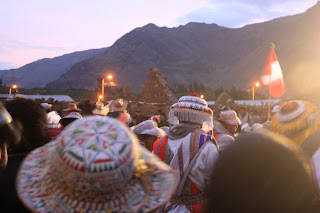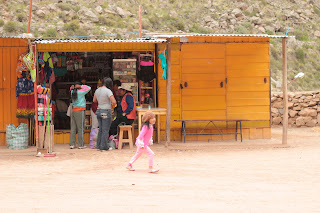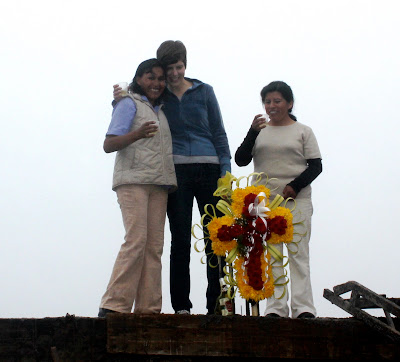I've been struggling quite a bit to find my footing these first weeks back in Arequipa, letting myself become easily frustrated by obstacles and cultural differences and often asking myself what I'm doing here in a country that will never fully make sense to me and where I will always be something of an outsider. Today, though, was a good reminder of the elements that keep pulling me back.
When I arrived at the beginning of this month, I found out from Andrea that she had managed to save enough money through her own hard work and with help from her sons, Elvis and Wilbur (pictured above with their mom), to construct a new addition to their house. One never knows how long such projects will take, but this Friday she informed me that construction was miraculously almost finished and Saturday would be the big day when the roof would go on and the roofing party, or
techamiento, would take place. She asked if I could come, and I told her I wouldn't miss it.
I, however, failed to understand that this invitation was Andrea asking me to be the
madrina, or sponsor, of the roof and that I should therefore come equipped with a large floral cross, champagne, candies and a speech. Luckily, Andrea realized this in time to cover all the bases and get everything together at the last minute, but it was a little discouraging to find myself still so inept at picking up on cultural clues and unable to fulfill the responsibilities that go with this kind of honor.

Once everything was ready, Andrea, Frida and I stood on wooden planks in the middle of the wet cement and, with some guidance from Frida on proper
techamiento etiquette, I gave the short
madrina speech thanking everyone for coming, congratulating Andrea, giving thanks that the heavy fog hadn't turned to rain and asking for blessings on the house and its occupants.
Then, according to custom, we took a hammer to the bottle of champagne and christened the house in the name of the Virgen de Candelaria, a popular manifestation of the Virgin Mary that Andrea had chosen in honor of the upcoming festival (still a hard choice, as there are an absolutely astounding number of Virgin Mary's to choose from).
We divvied up a second bottle into plastic cups, the three of us pouring a brindis, or offering, on the roof of the house so that blessings and prosperity would come to its inhabitants then toasting everyone who had come.
Finally, firecrackers went off and candy rained down on the friends and family of Andrea who were cheering below.
Beer (Arequipeña, of course) and pisco were brought out, music was turned on, and the party began.
Later, while we passed the communal glass and bottles of Arequipeña from person to person, Andrea recounted her slow but steady progress from sleeping, cooking, working and eating with her two sons in the tiny room that is now her kitchen, to secretly setting a few coins aside each month until she was able to buy up enough metal rods and bricks to construct two more rooms, and finally to this day, her two sons now grown, when the three of them were able to construct a space that might one day house her dream: her own knitting workshop.
"When people say they can't do it, that they just can't make it through, I tell them that anything can be done. I look at my two hands and my two feet and I give thanks, because with hard work anything is possible."
Ready for another week.
































